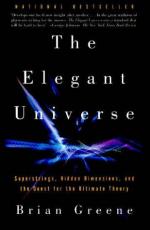
|
| Name: _________________________ | Period: ___________________ |
This quiz consists of 5 multiple choice and 5 short answer questions through Chapter 4, Microscopic Weirdness.
Multiple Choice Questions
1. What type of a wave is light?
(a) An electrical wave.
(b) A photonic wave.
(c) An electromagnetic wave.
(d) A gravitational wave.
2. Two theories form the basis of modern physics, but are incompatible with one another. String theory attempts to reconcile these fields. What are these two theories?
(a) Gravity and general relativity.
(b) General relativity and special relativity.
(c) Quantum mechanics and the photoelectric effect.
(d) General relativity and quantum mechanics.
3. Who discovered the theory of general relativity?
(a) Isaac Newton.
(b) Richard Feynman.
(c) Albert Einstein.
(d) Max Planck.
4. According to Newton's theory of gravity, if two objects have a gravitational pull on one another, and one changes its mass or distance from the other, how quickly does the effect of this change travel to the other object?
(a) At exactly the speed of light.
(b) Near the speed of light, faster for more massive objects.
(c) Instantaneously.
(d) Near the speed of light, faster for lighter objects.
5. According to Einstein's theory of general relativity, if two objects have a gravitational pull on one another, and one changes its mass or distance from the other, how quickly does the effect of this change travel to the other object?
(a) At exactly the speed of light.
(b) Instantaneously.
(c) Near the speed of light, faster for more massive objects.
(d) Near the speed of light, faster for lighter objects.
Short Answer Questions
1. In the 1800s, James Clerk Maxwell used a new mathematical framework to unite _____.
2. What property did the double-slit experiment demonstrate that light has?
3. What type of motion cannot be felt or sensed by the moving observer?
4. When the distance between two objects is doubled, what happens to the strength of the gravitational pull between them?
5. In 1968 it was discovered that protons and neutrons are composed of which type of particle?
|
This section contains 359 words (approx. 2 pages at 300 words per page) |

|




